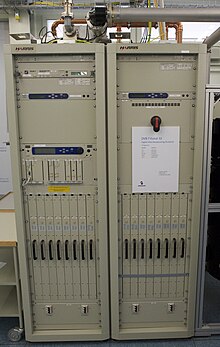
The Seven Network is a major Australian commercial free-to-air television network. It is owned by Seven West Media Limited, and is one of the five main free-to-air television networks in Australia. The network's headquarters are located in Sydney.
In most telecommunications organizations, a virtual channel is a method of remapping the program number as used in H.222 Program Association Tables and Program Mapping Tables to a channel number that can be entered as digits on a receiver's remote control.
XHAS-TDT is a television station in Tijuana, Baja California, Mexico, carrying Canal 66. It is owned by a Mexican company whose largest single investor is Entravision Communications, a U.S.-based operator of radio and television stations with radio and television stations in San Diego, including Univision affiliate KBNT-CD, and a similar interest in Milenio Televisión affiliate XHDTV-TDT. The transmitter is on Mount San Antonio in Tijuana.

XHIJ-TDT is a Spanish-language independent station in Ciudad Juárez, Chihuahua, Mexico, serving the Juárez–El Paso–Las Cruces metropolitan area. Owned by Grupo Intermedia and known on air as Canal 44, the station has had a variety of affiliations since signing on the air in 1980 and also produces programs such as local news.

XHRIO-TDT was a television station in Matamoros, Tamaulipas, Mexico, which served the Rio Grande Valley area in southern Texas, United States. The station was 98%-owned by Mexican-based Televisora Alco, a 40%-owned subsidiary of station operator Entravision Communications; XHRIO was a sister station to Entravision's duopoly of McAllen-licensed Univision affiliate KNVO and Harlingen-licensed Fox affiliate KFXV, as well as three low-powered stations, all licensed to McAllen: Class A UniMás affiliate KTFV-CD, KMBH-LD, and KCWT-CD. XHRIO-TDT maintained its basic concession-compliant studios in Matamoros, with a second studio facility across the border on North Jackson Road in McAllen housing master control and other internal operations. XHRIO-TDT's transmitter was located near El Control, Tamaulipas.
In broadcasting, digital subchannels are a method of transmitting more than one independent program stream simultaneously from the same digital radio or television station on the same radio frequency channel. This is done by using data compression techniques to reduce the size of each individual program stream, and multiplexing to combine them into a single signal. The practice is sometimes called "multicasting".

XEIMT-TDT, known as Canal 22, is a television station located in Mexico City. Broadcasting on channel 22, XEIMT is owned by Televisión Metropolitana, S.A. de C.V., and operated by the Secretariat of Culture. It is one of Mexico's principal public television stations, with a format emphasizing cultural programming.

This timeline of Australian television lists important station launches, programs, major television events, and technological advancements that have significantly changed the forms of broadcasting available to viewers of television in Australia. The history of television in Australia can be traced back to an announcement from the Menzies' government concerning plans for television services in Sydney and Melbourne.
7mate is an Australian free-to-air digital television multichannel, which was launched by the Seven Network on 25 September 2010. The channel contains sport and regular programs aimed primarily to a male audience, with programming drawn from a combination of new shows, American network shows and other shows previously aired on its sister channels Seven, 7two and 7flix.

Milenio Televisión is a Mexican television cable news channel owned by Grupo Multimedios. The news programming uses the resources of the Milenio newspaper, one of the largest in the country. Programming is 24 hours a day, through news, analysis and specialized programs. The channel is available in various pay TV systems throughout Mexico and the US, and on the internet. Milenio has also been available on the second digital subchannels of Multimedios television stations, as well as those of XHIJ-TDT and XHILA-TDT.

Ion Plus is an American free linear television network owned by the Scripps Networks subsidiary of the E. W. Scripps Company that formerly operated as a broadcast television network until February 28, 2021. The network originally launched in 2007 as Ion Life, maintaining a format featuring lifestyle programming focused on health and wellness, cooking, home decor, and travel. With expanded cable carriage, in 2019, Ion Media converted the network into a general entertainment format that matched that of parent network Ion Television, featuring day-long marathons of various drama series.

The Sistema Público de Radiodifusión del Estado Mexicano until 2014, is an independent Mexican government agency. Its mission is to support the development of public broadcasting in the country and expand its coverage. It carries out this goal through ownership of a nationwide network of transmitters and the management of its own public television channel, Canal Catorce. It also owns four radio transmitters.

Canal 44 is the television network of the Universidad de Guadalajara (UDG), a university in Jalisco, Mexico. The primary station, XHCPCT-TDT, broadcasts to the Guadalajara metropolitan area from a transmitter located on Cerro del Cuatro in Tlaquepaque, with additional transmitters in Ciudad Guzmán, Lagos de Moreno, and Puerto Vallarta. Canal 44 and the UDG's eight-station radio network form the Sistema Universitario de Radio y Televisión.
High-definition television in Australia is available via cable, IPTV, satellite and terrestrial television. The first high-definition broadcasts began in 2001 and since then the number of channels available to view has grown to a maximum of 27 that can be viewed on pay-TV service, Foxtel.

Excélsior TV is a Mexican FTA news channel owned by Grupo Imagen. It is named for Imagen's Excélsior newspaper and also uses the resources of Grupo Imagen's radio stations and its Imagen Televisión national network.

A Más is a national television network in Mexico operated by TV Azteca. It launched in five cities on March 20, 2017, and it expanded to 34 additional cities on April 7, 2017.

XHTDMX-TDT is a television station in Mexico City, an owned-and-operated station of the Monterrey-based Multimedios Televisión network. Owned by Grupo Firmas Globales through the subsidiary company Televisión Digital, S.A. de C.V., it broadcasts from the Canal Once tower on Cerro del Chiquihuite.
A digital multicast television network, also known as a diginet or multichannel, is a type of national television service designed to be broadcast terrestrially as a supplementary service to other stations on their digital subchannels. Made possible by the conversion from analog to digital television broadcasting, which left room for additional services to be broadcast from an individual transmitter, regional and national broadcasters alike have introduced such channels since the 2000s. By March 2022, 54 such services existed in the United States.












